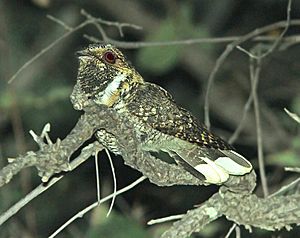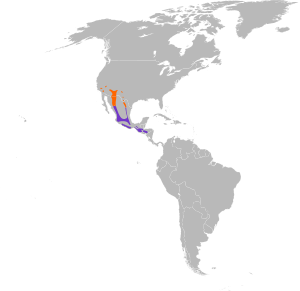Mexican whip-poor-will facts for kids
Quick facts for kids Mexican whip-poor-will |
|
|---|---|
 |
|
| Conservation status | |
| Scientific classification | |
| Genus: |
Antrostomus
|
| Species: |
arizonae
|
 |
|
| Synonyms | |
|
Caprimulgus arizonae |
|
The Mexican whip-poor-will (Antrostomus arizonae) is a medium-sized bird. It lives in the southwestern United States and Mexico. This bird is a type of nightjar, which means it is active mostly at night.
The Mexican whip-poor-will is famous for its song. Its name comes from the sound it makes, which sounds like "whip-poor-will!" This is called onomatopoeia, where a word sounds like what it describes.
This bird can grow to be about 22 to 27 centimeters long. That's about the length of a ruler!
Contents
About the Mexican Whip-poor-will
For a long time, the Mexican whip-poor-will was thought to be the same bird as the eastern whip-poor-will. But scientists found some important differences.
How They Are Different
Scientists discovered that these two birds are actually different species. Here's how they are not the same:
- Where they live: They have different ranges, meaning they live in different areas.
- Their songs: Each bird sings a different song.
- Their eggs: The eggs of each bird have different colors.
- Their DNA: Studies of their DNA (the genetic material that makes them unique) showed they are different enough to be separate species.
Appearance
The Mexican whip-poor-will has feathers that are a mix of colors. This helps it blend in with its surroundings.
Feather Colors
- Upper body: Its back and top parts are a mix of grey, black, and brown.
- Lower body: Its belly and bottom parts are grey and black.
Special Features
This bird has a very short beak. It also has a black throat. You can tell the difference between male and female birds by looking at their feathers:
- Males: They have a white patch just below their throat. Their outer tail feathers also have white tips.
- Females: These parts are light brown instead of white.
Ecology and Habitat
Mexican whip-poor-wills live in woodlands. You can find them in the southwestern United States and throughout Mexico.
Nighttime Habits
These birds are active at night. They fly around to catch insects in the air. During the day, they usually sleep. They are very good at hiding and blending in with their surroundings while they rest.
Nesting and Reproduction
Mexican whip-poor-wills build their nests on the ground. They choose shady spots among dead leaves. This helps keep their eggs hidden and safe. Usually, a female whip-poor-will lays two eggs at a time. The parent bird will stay very still on the nest. It will often not move even if someone walks very close to it!
See also
 In Spanish: Chotacabras cuerporruín mexicano para niños
In Spanish: Chotacabras cuerporruín mexicano para niños


